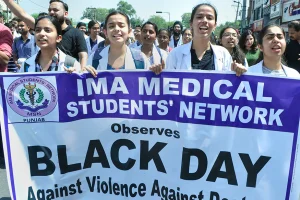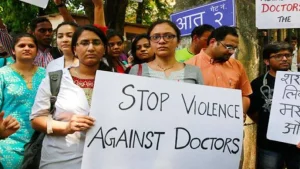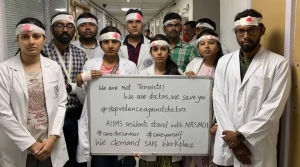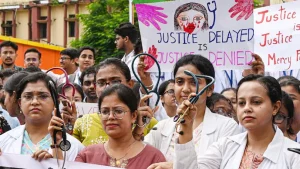Maharashtra witnessed an unprecedented healthcare disruption on September 18, 2025, as over 1.8 lakh allopathic doctors across the state participated in a 24-hour token strike. The massive doctors’ strike, organised by the Indian Medical Association (IMA) Maharashtra and supported by multiple medical organisations, has brought the state’s healthcare system to a near standstill, affecting millions of patients seeking medical care.
Also Read: Doctors’ Strike
Other: Modi 75th Birthday
Background of the Doctors’ Strike
The current doctors’ strike stems from the Maharashtra government’s controversial decision to allow Bachelor of Homoeopathic Medicine and Surgery (BHMS) doctors with Certificate Course in Modern Pharmacology (CCMP) certification to register under the Maharashtra Medical Council. This move has sparked fierce opposition from over 1.8 lakh doctors across Maharashtra, under the banner of the Indian Medical Association (IMA), who initiated the 24-hour strike starting from 8 am on September 18.
The doctors’ strike represents one of the largest medical protests in Maharashtra’s recent history, with participation from government hospitals, private medical institutions, and individual practitioners. According to IMA Maharashtra President Dr Santosh Kadam, while outpatient and routine services in government and private hospitals will remain shut, emergency medical services will continue to operate during the strike.
Key Participants in the Doctors’ Strike


The Maharashtra Association of Resident Doctors (MARD) has thrown its full support behind the doctors’ strike, with thousands of resident doctors participating in the protest. MARD has strongly objected to the permission granted to BHMS doctors to practice modern medicine after completing the CCMP course.
Medical officers from government hospitals, private practitioners, and faculty from medical colleges have also joined the doctors’ strike, making it a comprehensive protest representing virtually every segment of Maharashtra’s allopathic medical community.
Core Issues Behind the Doctors’ Strike
The primary concern driving this doctor’s strike centres on patient safety and medical standards. In a letter to the CM earlier, the IMA’s Maharashtra unit had argued that the decision would allow “inadequately” trained individuals to treat patients and could lead to misdiagnosis, adverse reactions, antibiotic resistance, and patient deaths, especially in rural areas.
The striking doctors argue that BHMS practitioners, even with CCMP certification, lack the comprehensive training required for modern medical practice. They stated that the move could allow individuals without proper training to treat patients, leading to possible misdiagnosis, harmful side effects, antibiotic resistance, and even deaths, particularly in rural areas.
This doctor’s strike also highlights concerns about the dilution of medical education standards and the potential compromise of healthcare quality in Maharashtra. The IMA contends that allowing BHMS doctors to practice allopathic medicine after a short certification course undermines the rigorous training that MBBS doctors undergo.
Impact of the Doctors’ Strike on Healthcare Services


Government hospitals have also been affected by the doctors’ strike, with routine OPD services suspended and only emergency cases being attended to. The strike has particularly impacted elective surgeries, diagnostic services, and routine consultations across the state.
However, the organisers of the doctors’ strike have ensured that emergency services remain functional. The emergency services will, however, remain operational, ensuring that critical patients continue to receive necessary medical care during the protest period.
Government Response and Future Implications
The doctors’ strike comes at a time when Maharashtra’s healthcare system is already under pressure. The government’s decision to register BHMS doctors under the Medical Council was intended to address the shortage of medical practitioners, particularly in rural areas. However, this doctor’s strike demonstrates the strong opposition from the medical community.
The timing of this doctor’s strike is particularly significant as it follows previous protests by homoeopathic doctors. More than 9,000 homoeopathic doctors in Maharashtra, all qualified under the Certificate Course in Modern Pharmacology (CCMP), had launched a hunger strike at Azad Maidan in July, which was later called off after receiving government assurance for review.
Long-term Consequences of the Doctors’ Strike
 This doctor’s strike raises important questions about medical education, professional standards, and healthcare delivery in Maharashtra. The protest highlights the ongoing tension between expanding healthcare access and maintaining quality standards. While the government seeks to address physician shortages, the medical community insists on preserving educational standards and patient safety.
This doctor’s strike raises important questions about medical education, professional standards, and healthcare delivery in Maharashtra. The protest highlights the ongoing tension between expanding healthcare access and maintaining quality standards. While the government seeks to address physician shortages, the medical community insists on preserving educational standards and patient safety.
The doctors’ strike also reflects broader national debates about the integration of alternative medicine with modern healthcare systems. The outcome of this protest may influence similar policies in other states and shape the future of medical practice in India.
Conclusion
The September 18 doctors’ strike in Maharashtra represents a critical moment in the state’s healthcare landscape. With over 1.8 lakh medical professionals participating, this unprecedented protest underscores the medical community’s commitment to maintaining professional standards and patient safety. As the doctors’ strike continues to impact healthcare services, it remains to be seen how the government will address the concerns raised by the medical fraternity while ensuring adequate healthcare access for Maharashtra’s population.
The resolution of this doctor’s strike will likely set important precedents for medical policy, professional standards, and healthcare governance not only in Maharashtra but across India. The strike serves as a powerful reminder of the delicate balance required between healthcare accessibility and medical quality in a complex healthcare ecosystem.


